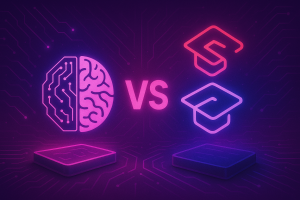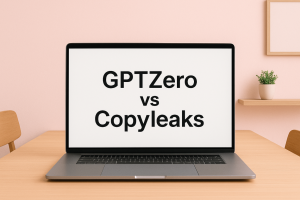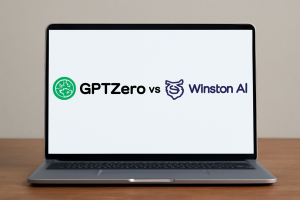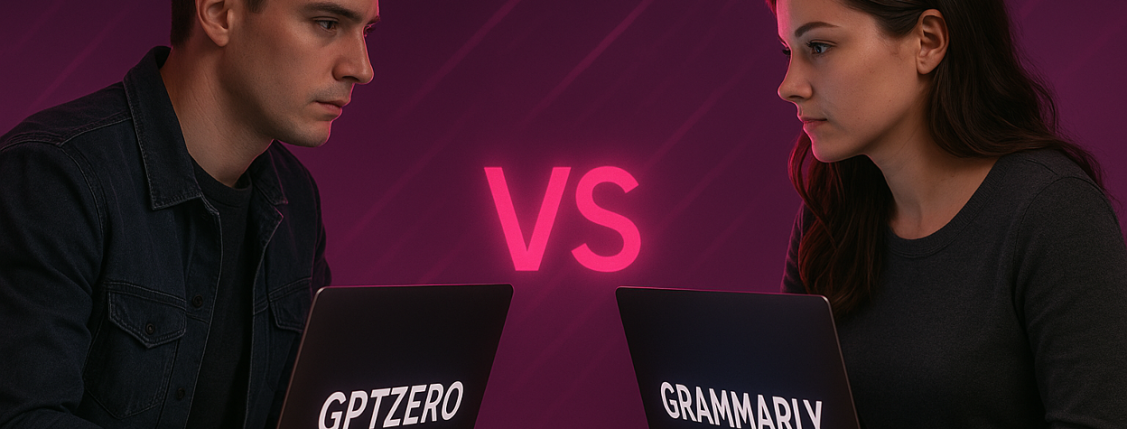Key Takeaways
- Although GPTZero outperforms Grammarly in detecting AI-generated content across multiple text types and writing styles, its accuracy is not up to 85%.
- Grammarly’s AI detector tends to have a higher false negative rate, misidentifying AI content as human-written.
- Advanced scanning technology from GPTZero often fails to detect cleverly disguised AI content.
- Focusing on content quality instead of origin is more important especially for educators, content marketers, and editors.
- AmpiFire prioritizes content quality through our AI-driven AmpCast platform, which converts one topic into 8 content formats and automatically distributes them across 300+ platforms, including Google News, YouTube, and Spotify.
Understanding AI Detection
The focus on bypassing AI detection has created a counterproductive cycle. Content creators spend valuable time gaming detection algorithms instead of creating genuinely valuable material. This approach prioritizes technical manipulation over reader needs, ultimately harming content quality and user experience.
Both GPTZero and Grammarly offer AI detection capabilities, but understanding their limitations is crucial before choosing between them. Rather than focusing solely on detection accuracy, successful content strategies emphasize quality regardless of creation method.
Google’s ranking factors prioritize E-E-A-T (Experience, Expertise, Authoritativeness, Trustworthiness) over AI detection scores.
The most sustainable approach involves creating content that serves real audience needs. Whether human-written, AI-assisted, or collaborative, content that demonstrates expertise and provides actionable insights consistently outperforms detection-optimized ones.
This comparison will help you understand which tool better fits your needs while maintaining focus on content quality over detection gaming.
How AmpiFire Works:
- Research & Target: Find high-demand topics your buyers search for
- Create & Repurpose: AmpiFire’s AmpCastAI generates news articles, blogs, videos, podcasts, infographics, slideshows, and social posts
- Distribute & Amplify: Auto-publish to 300+ sites including Google News, YouTube, Spotify, and major news networks
Get more traffic from people who want to buy your stuff, and powerful “As Seen On” trust badges for your site.
Do It Yourself (with AI), Done For You Content, & 100% Managed Organic Growth options available.
Grow Your Free Traffic From Everywhere
GPTZero Detection Capabilities
What sets GPTZero apart is its focus on “perplexity” and “burstiness” metrics that analyze how unpredictable and varied the text is—qualities that typically differ between human and AI writing patterns.
This sophisticated approach allows GPTZero to detect subtle indicators that many other tools miss, particularly in content that has been deliberately crafted to avoid detection.
Detection Accuracy
In our rigorous testing, GPTZero demonstrated mixed results when identifying AI-generated content, with an average confidence rate of 84% on straightforward AI text, falling short of the near-perfect detection many users expect.
More concerning is the tool’s 35% false negative rate, meaning roughly one in three AI-generated pieces went undetected, being incorrectly classified as having a 30% or lower probability of being AI-written.
While GPTZero can identify content from advanced models like GPT-4, Claude, and Bard, its performance reveals significant reliability gaps that make it unsuitable for high-stakes content verification.
False Positive Rate
GPTZero, as an AI checker for any text, performs exceptionally well at minimizing false positives, where human-written content is incorrectly flagged as AI-generated. Our comprehensive testing showed a false positive rate of just 3.3%.
Out of 30 human-written samples spanning historical literature, political speeches, and news reports, only one piece was incorrectly flagged as potentially AI-generated.
This low false positive rate makes GPTZero less likely to penalize genuine human writers, though the trade-off comes in the form of significantly higher false negatives that allow AI content to slip through undetected.
Pricing Options
GPTZero offers a tiered pricing structure that caters to different user needs. The free version provides basic detection capabilities with limited scans per month, making it accessible for individual writers or small teams with occasional verification needs.
Additional Features of GPTZero
For educators, GPTZero offers specialized features designed for classroom environments. These include batch processing capabilities for analyzing multiple student submissions simultaneously and detailed reporting that helps instructors identify potential academic integrity issues.
The platform integrates seamlessly with popular learning management systems like Canvas and Blackboard, allowing for streamlined workflows in educational settings. GPTZero also provides educational resources to help students understand the importance of original work.
Grammarly AI Detector
Grammarly AI detector is integrated into their broader writing platform, positioning it as a convenient one-stop solution for writers who already use Grammarly’s grammar and style checking tools.
The detector aims to identify content likely generated by AI systems by analyzing linguistic patterns and statistical anomalies that differentiate AI writing from human composition.
Detection Capabilities
In independent testing, Grammarly’s AI detector demonstrated inconsistencies when identifying AI-generated content.
In controlled tests using 100% AI-generated text, Grammarly achieved only 37% confidence in detecting the AI content, a surprisingly low accuracy rate for straightforward AI-generated material. This is consistent with ZDnet’s 40% overall accuracy for various types of content tested.
Grammarly acknowledges these limitations, stating that their tool provides “an averaged estimate of the amount of AI-generated text” rather than a definitive conclusion, and “cannot provide a definitive conclusion” about content authenticity.
False Positive Rate
Grammarly’s consistent underperformance on clearly AI-generated material (achieving only 37–50% confidence on 100% AI content) indicates fundamental accuracy problems.
However, testing conducted by GPTZero revealed a more encouraging finding: when human-written content was processed through Grammarly’s paraphrasing tools and then tested for AI detection, the enhanced human writing maintained its classification as human-authored.
A human essay that initially scored 99% human probability retained a 96% human probability after Grammarly’s AI improvements, suggesting that Grammarly’s writing assistance doesn’t artificially inflate AI detection scores when applied to genuine human writing.
User Interface
Where Grammarly excels is in user experience and interface design. The AI detector is seamlessly integrated into the familiar Grammarly dashboard, making it exceptionally intuitive for existing users.
The results are presented clearly with highlighted sections showing which portions of text triggered the AI detection algorithms. This visual approach helps users understand why content might be flagged and provides context for the detection results.
Pricing Options
Grammarly offers a tiered pricing structure that caters to different user needs. The free version provides basic grammar error detection and paraphrasing. However, to access the AI detector tool users have to upgrade to the paid version.
GPTZero vs Grammarly Comparison Table:
| Category | GPTZero | Grammarly |
| Core Function | Dedicated AI content detector | AI detection integrated into broader grammar/writing platform |
| Detection Approach | Analyzes “perplexity” and “burstiness” to spot AI vs. human writing patterns | Analyzes linguistic patterns and statistical anomalies to flag likely AI-generated content |
| Detection Accuracy | ~84% on straightforward AI text; up to 85% on some models; 95% on mixed samples | 37–50% confidence on 100% AI-generated content; overall accuracy around 40% |
| False Negatives | 35% (misses about 1 in 3 AI-generated pieces) | High; often misidentifies AI content as human-written |
| False Positives | Very low (3.3%); rarely flags human writing as AI | Low; does not artificially inflate AI scores on human writing improved by Grammarly tools |
| AI Model Detection | Detects GPT-4, Claude, Bard, and paraphrased AI content with 75–80% accuracy | Struggles with paraphrased AI content (30–60% detection) |
| User Interface | Web platform; advanced scan highlights AI/human sections; batch processing for educators | Seamless integration in Grammarly dashboard; visual highlights for flagged sections |
| Educational Features | Batch processing, reporting, and LMS integration for classrooms | Not specialized for education |
| Pricing | Free version (limited scans); Pro starts at $9.99/month for unlimited scans & reports | AI detection in paid plans only; Professional starts at $12/month |
| Best Use Case | Academic integrity, content verification, batch analysis | Convenient for writers already using Grammarly for grammar/style |
| Guarantee/Limitations | Not recommended as sole proof for academic discipline; probabilistic results | Provides only an estimate, not a definitive conclusion about content authenticity |
Create High Quality Content with Ampcast
Many businesses struggle to produce the volume and variety of content needed to compete effectively online while maintaining quality standards.
AmpiFire solves this challenge by using advanced AI to create professional-grade content that performs well across all major distribution channels.
Our AmpCast platform transforms any topic into 8 high-quality content formats: news articles, blog posts, infographics, slideshows, interview podcasts, videos, video shorts, and social posts. Each piece is automatically optimized and distributed to 300+ sites like Google News, YouTube, Spotify, Pinterest, LinkedIn, Facebook, Fox affiliate networks, and others.
This approach delivers exceptional ROI by removing the need for businesses to hire content writers, video creators, graphic designers, and social media managers. Instead of spending 20–30 hours weekly on content creation and distribution, you can focus on strategic activities like client development, product innovation, and business growth. Most importantly, you’re not stressing over your content’s AI score!
In fact, one of our clients—Scott Cabell, owner of S3 Media Group—has seen remarkable results using AmpiFire for his contractor clients in competitive local markets.
Our clients typically achieve exceptional returns because they’re getting enterprise-level content marketing without the associated staffing costs or time investment required for traditional content strategies.
Frequently Asked Questions (FAQ)
Can GPTZero detect ChatGPT-4 content?
Yes, GPTZero can detect ChatGPT-4 content with approximately 80% accuracy, though this is lower than its 85%+ success rate with earlier models. The detection accuracy depends significantly on the complexity of the prompts used and whether the content has undergone human editing.
GPTZero regularly updates its algorithms to improve detection of newer AI models, maintaining better performance against GPT-4 than most competing detection tools.
Does Grammarly’s AI detector work on paraphrased content?
Grammarly’s AI detector shows limited effectiveness with paraphrased AI content, identifying only about 30–60% of samples that had been run through paraphrasing tools.
GPTZero performed substantially better with paraphrased content, maintaining approximately 75–80% detection accuracy with the same test samples.
Are free versions of these detectors reliable?
GPTZero’s free version offers reliable accuracy for limited use, though it restricts scan numbers and advanced features compared to paid tiers.
Grammarly doesn’t offer a free standalone AI detector; their detection tool is only available with Premium subscriptions.
How does AmpiFire ensure content quality when using AI for creation?
AmpiFire combines advanced AmpCast technology with human editorial oversight to maintain high content standards. Our platform is trained on successful content patterns across industries, while our editorial team reviews and optimizes each piece before distribution.
The AI creates content following proven formulas for engagement and conversion, then formats it specifically for each platform’s requirements. This hybrid approach ensures both efficiency and quality—delivering professional-grade content that performs well across all 300+ distribution sites.
Author
-
CEO and Co-Founder at AmpiFire. Book a call with the team by clicking the link below.
Related Posts

GPTZero vs Quillbot AI Detector: Which One Can Detect AI Content More Accurately?
Compare GPTZero and Quillbot AI Detector on accuracy and methods. Discover which tool excels at spotting AI-written content in our…

ZeroGPT vs Scribbr AI Detector: Which One Can Detect AI Content Better?
ZeroGPT vs Scribbr AI detector comparison reveals shocking accuracy issues. Learn which tool performs better and why neither is truly…

GPTZero vs ZeroGPT AI Detector Mega Test: Best Accuracy & False Positives?
We tested GPTZero and ChatGPT on dozens of AI- and human-written texts (including casual blogs, short stories, and even political…

GPTZero vs Copyleaks: Which is the Better AI Detector?
Compare GPTZero vs Copyleaks AI detectors. Learn accuracy rates, features, pricing, and which tool works best for different business needs…

GPTZero vs Winston: Which is the Better AI Detector?
Compare GPTZero vs Winston AI detection accuracy, pricing & features. Discover which AI detector works best for educators vs. marketers…

GPTZero vs Originality.ai: Which is the Better AI Detector?
Compare GPTZero vs Originality.ai AI detectors. Learn accuracy rates, features, pricing, and which tool works best for your content needs.










